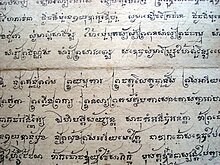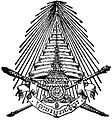Khom Thai script
| Khom Thai | |
|---|---|
 A Buddhist manuscript written in Khom Thai. | |
| Script type | Abugida
|
Time period | c. 1400 CE - present[1] |
| Direction | left-to-right |
| Languages | Pali, Sanskrit, Khmer, Thai |
| Related scripts | |
Parent systems | Proto-Sinaitic alphabet
|
Sister systems | Sukhothai |
| Brahmic scripts |
|---|
| The Brahmic script and its descendants |
The Khom Thai script (Thai: อักษรขอมไทย, romanized: akson khom thai, Lao: ອັກສອນຂອມ, romanized: Aksone Khom, Khmer: អក្សរខម, romanized: ʼaksɑɑ khɑɑm) is a Brahmic script and a variant of the Khmer script used in Thailand, which is used to write Pali, Sanskrit, Khmer and Thai.
History[]
The Thai adopted the ancient Khmer script as their official script around the 10th century, during the territorial expansion of the Khmer Empire, because the Thai language lacked a writing system at the time. The ancient Khmer script was not suitable for writing Thai, however, because of phonological differences between the Thai and Khmer languages.[2] Around the 15th century, the Thai added additional letterforms and letters to the script be able to write the Thai language. They called this new version of the Khmer script “Khom”, which means “Khmer” in Thai. Punnothok (2006) indicated that the Khom Thai script has been used alongside the Thai script since the 15th century. The two scripts are used for different purposes, the Thai script is used for writing non-religious documents, while the Khom Thai script is mainly used for writing religious texts.[2] The Khom Thai script closely resembles the Aksar Mul script used in Cambodia, but some letters differ. The Khom Thai letterforms have not changed significantly since the Sukhothai era. The Khom Thai script was the most widely used of the ancient scripts found in Thailand.[3]
Use of the Khom Thai script has declined for three reasons. Firstly King Rama IV (1804-1868) ordered Thailand's Buddhist monks to use the Thai script when writing Pali, instead of Khom Thai.[4] Secondly, King Rama V (1853-1910) ordered the translation of the Tripiṭaka from Pali into Thai, using the Thai script. The third reason was the scrapping of the Khom Thai script from the Buddhist studies exam, the . In 1918, the Pali division of the Buddhist Association decided to again include an assignment about the Khom Thai script on the test, out of concern that the Khom Thai script would disappear. However, the Ministry of Education decided to cancel the Sanam Luang test permanently in 1945, on the basis of the government’s nationalist and modernizing policies, which ended the study of the Khom Thai script at Buddhist institutes and schools and made it less necessary for monks and students to learn the Khom Thai script.[5] Tsumura (2009) pointed out that educational reforms in 1884 and 1921 were pivotal factors that worsened the situation for the Khom Thai script.[5] Since the national policies in that period focused on centralizing political power in Bangkok, the educational system tended to disregard traditional knowledge from outside of the capital, including the use of the Tham script, the Tai Noi script, and the Khom Thai script.[6]
Nowadays, the Khom Thai script is part of a required course for students of oriental palaeography in certain Thai universities including Silpakorn University. However, accessibility to information about the script is limited for ordinary Thais interested in the subject, and it receives little attention from the public in general.[7]
Usage[]
Examples of the script can be found in Buddhist texts called Samut khoi, medicinal texts, magical textbooks, and various talismanic images, most of them appearing in central Thailand, but they may also be found in the southern and northeastern parts of Thailand.[citation needed] The Khom Thai script is considered a sacred script,[2] and its status is similar to the Siddhaṃ script used by Mahayana Buddhism.
Owing to the influence of Khmer occultism, it is common for Thai men to have their bodies ritualistically and symbolically marked with Khom Thai script— structured in various forms of “yantra”, called yantra tattooing.[8][9] The script is also used for yantras on cloth, paper, or engravings on brass plates in Cambodia and Thailand.[10][11]

The Khom Thai script on a Buddhist illustration
The Buddha legend written in the Khom Thai script - Ethnological Museum, Berlin

The Suvannasama Jataka, in Pali language in the Khom Thai script

Thai Seal of the Royal Command: which reads "ព្រះបរម្មរាជឱង្ការ" (พฺระบรมฺมราชโองฺการ, royal command)
Thai amulet or "Yantra" featuring the Khom Thai script

Pali manuscript from Thailand, written in Khom Thai script
Characteristics[]

The Khom Thai script is written from left to right.[12] As the Khmer script does not contain tone symbols, some Thai vowels and tone symbols have been added to the Khom Thai script.[13]
The script is characterized by sharper serifs and angles than the Khmer script, and retainment of some antique characteristics, notably in the consonant kâ (ក).[10][11]
Consonants[]
There are 35 full form letters in total, used for initial consonants. Most of these also have a subscribed form letter, which is used for word final consonants.[14]
| Velar |  ka ก |
 kha ข |
 ga ค |
 gha ฆ |
 ṅa ง |
|---|---|---|---|---|---|
| Alveolo-palatal |  ca จ |
 cha ฉ |
 ja ช |
 jha ฌ |
 ña ญ |
| Alveolar |  ṭa ฏ |
 ṭha ฐ |
 ḍa ฑ |
 ḍha ฒ |
 ṇa ณ |
 ta ต |
 tha ถ |
 da ท |
 dha ธ |
 na น | |
| Labial |  pa ป |
 pha ผ |
 ba พ |
 bha ภ |
 ma ม |
| Fricative, liquid and guttural |  ya ย |
 ra ร |
 la ล |
 va ว |
 śa ศ |
 ṣa ษ |
 sa ส |
 ha ห |
 ḷa ฬ |
 a อ |
Vowels[]
The Khom Thai script has two kind of vowels, namely, indepent vowels that can be written alone, and dependent vowels that have to be combined with consonants to form words.[14] The dependent vowels are identical to their Thai counterparts.[15]
The following are 8 independent vowels:
 a อะ |
 ā อา |
 i อิ |
 ī อี |
 u อุ |
 ū อู |
 e เอ |
 o โอ |
Tone marks[]
The tone marks of the Khom Thai script are identical to those of the Thai script.[15]
Numerals[]
The numerals used by the Khom Thai script resemble Thai and Khmer numerals, and feature long ascenders.[16]
Computerization[]
The Khom Thai script has not been included in Unicode, but Khom Thai fonts can be used with Thai encoding.
Farida Virunhaphol designed three Khom Thai fonts for teaching purposes. This set of fonts enables Thai users to become familiar with Khom Thai faster.[17]
References[]
- ^ Virunhaphol 2017, pp. 154.
- ^ Jump up to: a b c Virunhaphol 2017, pp. 22.
- ^ Virunhaphol 2017, pp. 155.
- ^ Virunhaphol 2017, pp. 23.
- ^ Jump up to: a b Virunhaphol 2017, pp. 24.
- ^ Virunhaphol 2017, pp. 25.
- ^ Virunhaphol 2017, pp. 26.
- ^ Cadchumsang, Jaggapan (2011). "People at the Rim: A Study of Tai Ethnicity and Nationalism in a Thai Border Village". Retrieved 24 June 2021. Cite journal requires
|journal=(help) - ^ May, Angela Marie. (2014). Sak Yant: The Transition from Indic Yantras to Thai Magical Buddhist Tattoos (Master's thesis) (p. 6). The University of Alabama at Birmingham.
- ^ Jump up to: a b Igunma, Jana (2013). "Aksoon Khoom: Khmer Heritage in Thai and Lao Manuscript Cultures. Tai Culture, 23: Route of the Roots: Tai-Asiatic Cultural Interaction". Cite journal requires
|journal=(help). - ^ Jump up to: a b Tsumura, Fumihiko (2009). "Magical Use of Traditional Scripts in Northeastern Thai Villages. Senri Ethnological Studies, 74,": 63–77. Cite journal requires
|journal=(help) - ^ "ประวัติอักษรขอมไทย". Archived from the original on 2017-07-15. Retrieved 2017-09-28.
- ^ "Buddhist Texts, Including the Legend of Phra Malai, with Illustrations of The Ten Birth Tales". Retrieved 2017-09-30.
- ^ Jump up to: a b Virunhaphol 2017, pp. 106.
- ^ Jump up to: a b Virunhaphol 2017, pp. 136.
- ^ Virunhaphol 2017, pp. 133.
- ^ Virunhaphol 2017, pp. 111.
Sources[]
- Virunhaphol, Farida (2017). "Designing Khom Thai Letterforms for Accessibility (Doctoral dissertation). University of Huddersfield" (PDF). Cite journal requires
|journal=(help)
External links[]
| Wikimedia Commons has media related to Khom Thai Script. |
- Brahmic scripts
- Inscriptions of Thailand
- Khmer script




